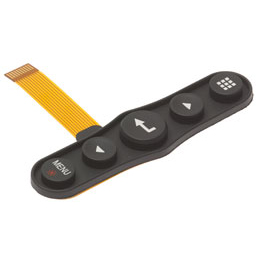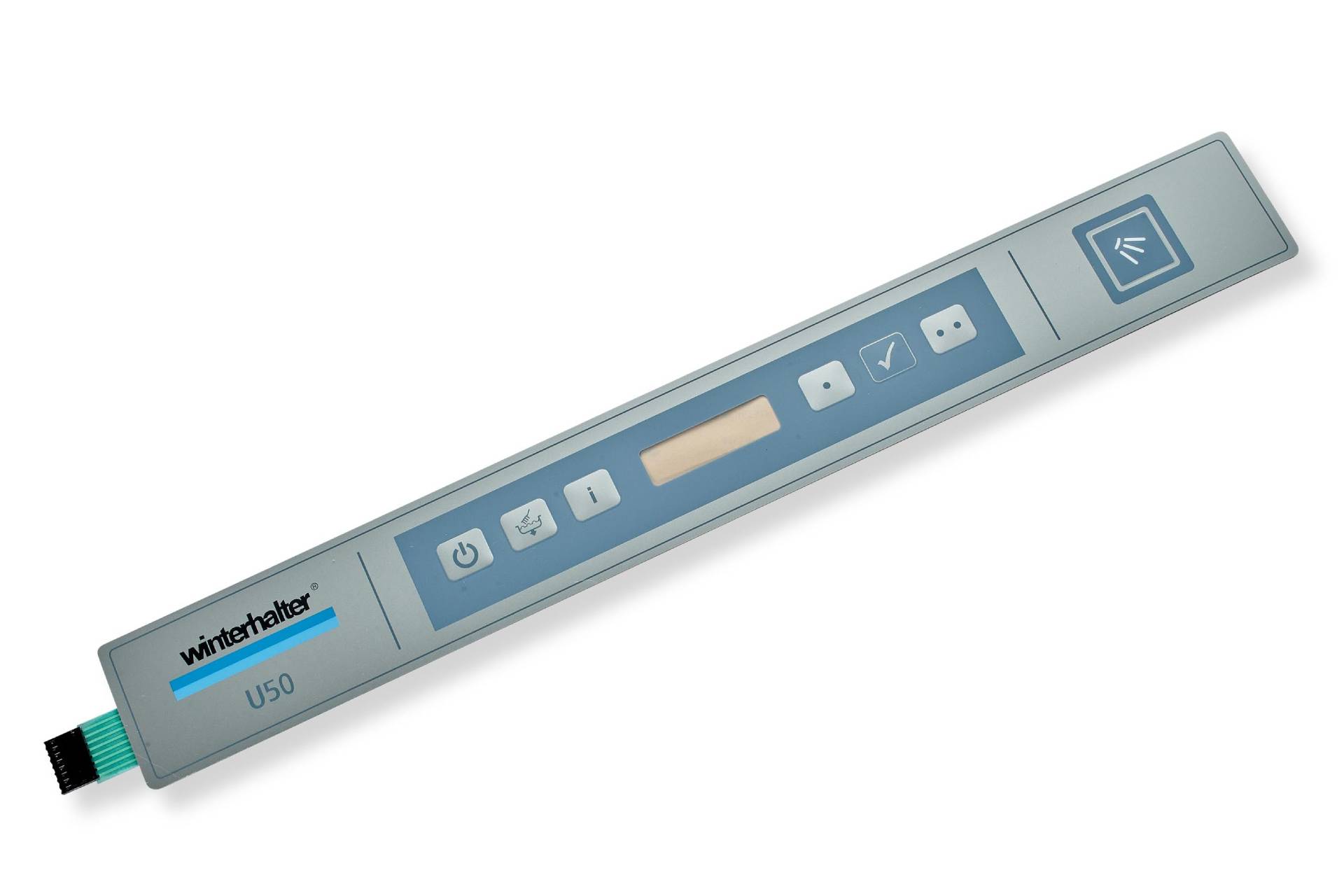A Comprehensive Overview to the Manufacturing and Handling of Rubber Keypads for Optimal Efficiency
The production and handling of rubber keypads play a vital function in their performance and usability. Material choice, design accuracy, and innovative production methods greatly affect their durability and effectiveness. Comprehending these aspects is essential for creating top notch items. As various developments arise in this field, discovering their effects could disclose new criteria for capability and user experience. What vital aspects will shape the future of rubber keypads?
Understanding Rubber Keypads: Products and Types
Rubber keypads are essential elements in countless tools, supplying a balance of durability and tactile comments. These keypads are mainly made from silicone or artificial rubber, materials picked for their adaptability and durability. Silicone rubber, specifically, is preferred for its superb temperature level resistance and durability, making it optimal for various applications, from consumer electronics to commercial machinery.
There are numerous kinds of rubber keypads, consisting of dome button keypads, which use a dome-shaped system that provides responsive feedback when pushed. Furthermore, there are likewise level keypads, which feature a smooth surface and are frequently utilized in medical tools and remote controls. The choice of product and kind influences the keypad's performance, really feel, and overall user experience. Comprehending these aspects is important for developers and makers aiming to develop trusted and reliable interfaces in their items.
The Manufacturing Process: From Layout to Production
The production procedure of rubber keypads involves several important phases, beginning with style and ending with production. At first, developers produce detailed requirements and prototypes, assuring the keypad satisfies aesthetic and practical needs. Computer-aided layout (CAD) software application is frequently used to visualize the format and functions prior to continuing.
When the design is wrapped up, material option is crucial, with options normally consisting of silicone or all-natural rubber. In the next phase, molds are created based upon the authorized designs, which will certainly form the keypads during production.
Adhering to mold creation, the production stage commences, where rubber is blended with ingredients to enhance performance. The combination is then poured into mold and mildews and based on warmth and pressure, allowing it to strengthen and heal.
Lastly, the ended up keypads undertake top quality checks to verify they meet well established criteria, complied with by packaging for distribution. This all-encompassing process assurances peak efficiency in the final item.
Trick Strategies in Rubber Molding
In the domain name of rubber keypads, various molding methods play a critical duty in establishing the top quality and capability of the end product. One widespread technique is compression molding, where raw rubber is placed in a warmed mold and mildew and stress is used, enabling reliable mass production and harmony. An additional significant strategy is shot molding, which entails infusing heated rubber into a mold, offering greater accuracy and complex shapes. Transfer molding, a hybrid of both methods, is also utilized, specifically for intricate designs, as it incorporates the benefits of both procedures. Furthermore, liquid silicone rubber (LSR) molding is getting grip due to its versatility and resilience, making it ideal for high-performance applications. Each technique possesses special characteristics, influencing elements such as cycle time, material waste, and manufacturing prices. Choosing the appropriate molding strategy is crucial for achieving peak performance in rubber keypads.
Surface Area Finishing and Texturing Options
Surface ending up and texturing alternatives play an important duty in boosting the responsive experience and visual appeal of rubber keypads. Suppliers utilize different strategies to create unique surface characteristics that impact customer communication and item style. Common completing methods consist of matte, glossy, and satin coatings, each offering different aesthetic results and grasp degrees. Texturing choices, such as increased patterns, grooves, or stippling, additionally enhance performance by enhancing grip and lowering slippage throughout usage.
In addition, certain textures can be tailored to fulfill ergonomic requirements, offering convenience during prolonged usage. The choice of surface area coatings and textures can be influenced by the designated application of the keypad, whether it be for customer electronic devices, automotive controls, or industrial tools. Ultimately, careful factor to consider of these options contributes greatly to individual satisfaction and overall item performance, making them critical components in the layout and production procedure of rubber keypads.
Top Quality Control Measures in Rubber Keypad Production
Quality assurance procedures in rubber keypad production are critical for making certain item dependability and efficiency. These steps incorporate product selection criteria, strenuous screening treatments, and strict final inspection criteria. Together, they develop a thorough structure that aids suppliers maintain top quality throughout the production process.

Product Choice Requirements
Selecting the proper materials for rubber keypads is important, as it straight impacts their individual, functionality, and toughness experience. Key requirements for product option include tensile toughness, resilience, and environmental resistance. The selection of rubber substance, such as silicone or polycarbonate elastomer (TPE), plays a vital role in attaining wanted tactile feedback and longevity. Additionally, factors like chemical compatibility, temperature stability, and UV resistance have to be taken into consideration to guarantee optimal efficiency in various applications. Makers must additionally review the ease of processing and cost-effectiveness of products, balancing quality with budget constraints. Eventually, the right material selection not only improves the keypad's performance however also adds to total item high quality and customer satisfaction.
Examining Treatments Implemented
After establishing the ideal materials for rubber keypads, rigorous testing treatments are applied to confirm that the end products meet sector requirements and consumer assumptions. These treatments generally include mechanical screening, which reviews the toughness and flexibility of the rubber under different conditions. Furthermore, environmental screening analyzes the keypads' performance under temperature variations, moisture, and direct exposure to chemicals. Electrical testing confirms the keypads work appropriately with electronic components, validating responsiveness and conductivity. Tactile comments is reviewed to guarantee individual satisfaction. These substantial testing steps go to the website are important in identifying any disparities or issues before automation, ultimately improving the reliability and efficiency of rubber keypads in their desired applications.
Final Examination Standards
Detailed last evaluation requirements are vital in rubber keypad production to guarantee that each unit meets the specified requirements for performance and appearance. This procedure typically involves aesthetic analyses to determine any kind of surface issues, such as staining or imperfections. Furthermore, tactile evaluations identify that the keypads react properly to touch, preserving the required degree of level of sensitivity. Longevity examinations may additionally be performed, mimicing prolonged usage to verify the longevity of the keypad under numerous conditions. Furthermore, adherence to market guidelines and customer specifications is validated to preserve quality control. By executing these extensive examination steps, manufacturers can considerably minimize the danger of issues, ensuring that the final item is reliable and meets consumer assumptions, eventually boosting consumer complete satisfaction.
Developments in Rubber Keypad Innovation
As modern technology remains to progress, innovations in rubber keypad modern technology are reshaping individual interfaces across different markets. One considerable improvement is the combination of capacitive touch sensing units within rubber keypads, enabling a more responsive and flexible individual experience. This innovation enables users to connect with tools through touch, enhancing capability without giving up the responsive responses that rubber keypads are understood for.
Additionally, renovations in product formulas have actually caused the growth of more sturdy, weather-resistant rubber, making keypads suitable for outdoor and industrial use. Enhanced printing strategies likewise permit high-resolution graphics and backlighting choices, boosting exposure and visual charm.

Additionally, developments in producing procedures, such as 3D printing, are allowing customized layouts and fast prototyping, improving production timelines. These technologies jointly contribute to extra user-friendly and effective rubber keypads, ensuring they fulfill the demands of modern applications while maintaining their core benefits.
Best Practices for Layout and Functionality
Designing reliable rubber keypads needs cautious examination of both aesthetics and capability. Rubber Keypads. A properly designed keypad must stabilize ergonomic principles with aesthetic interest improve individual experience. Secret variables include dimension, form, and spacing of buttons, ensuring they are easy to press while protecting against accidental activation. Making use of contrasting shades and structures can boost exposure and tactile comments, assisting individuals in differentiating in between secrets
In addition, the choice of materials plays an important duty; top quality rubber compounds can boost durability and resistance to wear. It is also important to consider the combination of features such as backlighting and custom graphics, which can improve functionality in various atmospheres.
Prototyping and user testing are indispensable in the style procedure, enabling for modifications based on real-world responses. By sticking to these best methods, producers can produce rubber keypads that not just look appealing yet likewise meet the useful demands of individuals effectively.
Regularly Asked Inquiries
Just how Do I Select the Right Rubber Product for My Keypad?
To choose the right rubber material for a keypad, one must think about factors such as durability, environmental resistance, responsive feedback, and compatibility with the desired application, ensuring ideal performance and individual fulfillment in various problems.
What Are the Ecological Effects of Rubber Keypad Manufacturing?
Rubber keypad manufacturing can result in ecological influences such as logging for natural rubber sources, pollution from chemical processes, and waste generation. Sustainable practices and products can alleviate several of these unfavorable impacts on communities.
Can Rubber Keypads Be Recycled or Recycled?
Rubber keypads try this out can be reused, however the procedure depends upon the certain products used in their production. Reusing them in various applications is likewise possible, adding to throw away reduction and promoting sustainability in making methods.
What Is the Typical Life Expectancy of a Rubber Keypad?
The typical life-span of a rubber i loved this keypad normally varies from 5 to 10 years, depending upon use, environmental aspects, and maintenance. Regular treatment can expand its capability, while excessive wear may reduce its sturdiness.
Are There Any Type Of Health And Wellness Problems Associated With Rubber Keypad Materials?
There are potential health problems connected to rubber keypad products, consisting of allergies to particular chemicals and toxic irritants made use of in production. Appropriate handling and awareness of material composition can alleviate these risks for customers.
There are numerous kinds of rubber keypads, consisting of dome switch keypads, which utilize a dome-shaped device that supplies responsive responses when pressed. Picking the proper products for rubber keypads is vital, as it directly impacts their resilience, individual, and functionality experience - Rubber Keypads. After identifying the ideal products for rubber keypads, strenuous screening procedures are executed to verify that the final items meet market criteria and client expectations. Rubber keypad production can lead to environmental impacts such as deforestation for all-natural rubber sources, pollution from chemical processes, and waste generation. Rubber keypads can be reused, but the procedure depends on the certain products used in their production